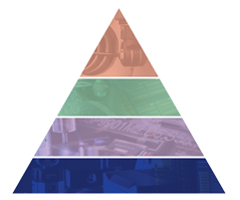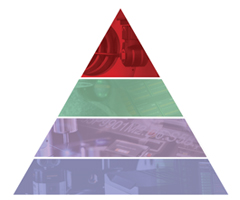제조 방식의 변화
공정 제어 전문가의 도움으로 제조 성능에 변화를 주고 실질적인 결실을 거두십시오.
- 현재 가지고 있는 장비를 통한 생산성 향상
- 자동화 개선 및 인력 투입 감소
- 재작업, 클레임, 불량률을 줄이세요
- 역량을 강화하고 더 많은 작업을 수행하세요
공정 변이를 원천적으로 해결 ...
프로세스 변이는 경쟁력과 수익성에 저해가 되는 적입니다. 낭비와 비효율을 유발할 뿐 아니라 품질 유지 비용과 인건비를 높이고 납품이 지연되고 추적이 어려워지는 문제를 낳습니다.
일관되고 자동화된 생산적 가공 작업의 비밀은 변이의 출처를 이해하고 그러한 변이를 원천적으로 다루는 방법을 파악하는 것입니다.
Renishaw의 Productive Process Pyramid™는 공장에서 변이를 일으키는 요소를 찾고 제어할 수 있는 토대를 제공하며, 혁신적인 기술과 입증된 방법론 및 전문가 지원이 이를 뒷받침합니다. Renishaw는 '그린 버튼' 또는 '라이트 아웃' 가공 작업 목표를 현실화하는 데 도움을 드릴 수 있습니다.
그리고 실질적인 결실을 거둘수 있습니다.
- 기존 생산장비로 생산성 향상
- 자동화 개선 및 인력 투입 감소
- 재작업, 재생산, 컨세션 및 불량률 감소
- 제조 리드 타임 단축
- 역량 및 추적 기능 향상
- 비용 관리 및 수익성 증가
Productive Process Pyramid™
Productive Process Pyramid™는 어떤 방식으로 여러 단계의 제어 기능이 효과적으로 구축되어 가공 공정에서 변이를 체계적으로 제거함으로써 처리량을 높이고 표준화된 생산 방식을 극대화하고 인력에 의한 오차를 없애는지 보여줍니다.
네 가지 계층
예측 가능한 생산적 제조를 실현할 수 있도록 지원하는 네 가지 계층에 대해 알아보십시오.
공정 기초

공정 토대 계층은 공정을 수행하는 안정적인 환경을 제공합니다. 여기에는 기계 자체의 성능및 최적화된 모니터링이 포함됩니다.
이러한 예방적 제어는 가공 작업이 시작되기 전에 변이 원인을 상당 부분 줄여줍니다.
공정 세팅

공정 세팅 계층은 기계에서 부품의 위치, 공구 크기 및 오프셋 등 공작물을 규격에서 이탈하게 만드는 변동 원인을 처리합니다.
이러한 예측적 제어는 절삭 시작 직전에 적용됩니다.
공정내 제어

공정내 제어 계층은 공구 마모 및 온도 변동 등 가공에 내재된 변동 원인을 해소시키기 위해 가공이 진행되는 동안 공정 및 의사 결정 과정에 지능적 피드백을 제공합니다.
이러한 적극적 제어는 금속 절삭 중에 적용됩니다.
공정 후 모니터링

끝으로, 공정 후 모니터링 계층은 공정과 완성된 부품을 사양과 비교, 점검하며 로깅 공정 경로와 결과를 확인합니다.
이러한 정보 제공용 제어는 가공 작업 완료 후 적용됩니다.
공정 제어 활동
각 피라미드 계층은 가공 작업 공정 변이의 모든 원인을 찾아내는 일련의 제어 기능으로 구성됩니다.
문서
-
 Brochure: Metrology solutions for productive process control [en]
Brochure: Metrology solutions for productive process control [en]
Transform your manufacturing performance with help from the process control experts
